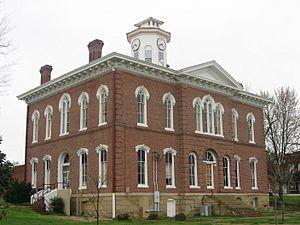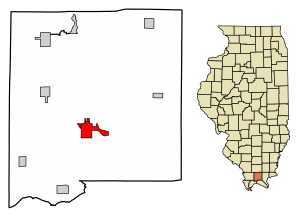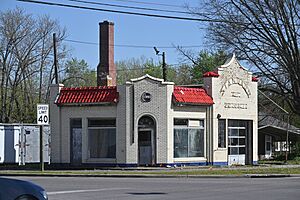Vienna, Illinois facts for kids
Quick facts for kids
Vienna
|
|
|---|---|

Johnson County Courthouse
|
|

Location of Vienna in Johnson County, Illinois.
|
|

Location of Illinois in the United States
|
|
| Country | United States |
| State | Illinois |
| County | Johnson |
| Area | |
| • Total | 2.87 sq mi (7.44 km2) |
| • Land | 2.84 sq mi (7.35 km2) |
| • Water | 0.04 sq mi (0.10 km2) |
| Elevation | 364 ft (111 m) |
| Population
(2020)
|
|
| • Total | 1,343 |
| • Density | 473.39/sq mi (182.80/km2) |
| Time zone | UTC-6 (CST) |
| • Summer (DST) | UTC-5 (CDT) |
| ZIP Code(s) |
62995
|
| Area code(s) | 618/730 |
| FIPS code | 17-77863 |
| GNIS feature ID | 2397137 |
| Wikimedia Commons | Vienna, Illinois |
Vienna (pronounced vy-AN-uh) is a city in Johnson County, Illinois, United States. It is the main town, also known as the county seat, for Johnson County. The city had a population of 1,343 people in 2020.
Contents
History of Vienna, Illinois
Vienna started as a trading post for Native Americans in the early 1800s. It was planned out as a town in 1818, the same year Illinois became a state. The town was named the county seat and later became a village in 1837. It officially became a city in 1893. Vienna has been the county seat for nearly 200 years. The first post office opened here in 1821, even before the town was officially formed.
The Trail of Tears in Vienna
In the 1830s, Vienna was a place where many Native Americans were forced to travel through. This was part of a sad event called the Trail of Tears. Tens of thousands of Native Americans were made to move from their homes to Oklahoma by the U.S. government. They faced very difficult conditions, like walking barefoot in winter. Thousands of people died because of these harsh conditions.
Historic Johnson County Courthouse
The Johnson County Courthouse was built in 1868. It is one of the oldest courthouses in Illinois that is still being used today. Building it cost about $80,000 back then. That would be like spending about $1.5 million today.
Places to Visit in Vienna
Vienna is close to several interesting natural areas and historical sites.
- Heron Pond - Little Black Slough Nature Preserve: This is a special natural area, recognized as a National Natural Landmark. It is a great place to see nature.
- Tunnel Hill State Trail: The main office and starting point for this popular trail are located right in Vienna.
- Trail of Tears Commemorative Site: In the city park, you can find a special totem pole and flags. They mark the halfway point of the historic Trail of Tears.
- Johnson County Courthouse: This historic building is in Vienna.
- Vienna Public Library: The city's library is also on the National Register of Historic Places.
- Dixon Springs State Park: This park is a short drive away in Dixon Springs.
- Garden of the Gods Wilderness: East of Vienna, this wilderness area offers many trails for hikers to explore.
Education in Vienna
Vienna has two school districts, serving about 700 students. The city is home to Vienna Grade School and Vienna High School. For students who want to continue their education, Shawnee Community College in Ullin and Southern Illinois University Carbondale in Carbondale are nearby.
Getting Around Vienna
Even though Vienna does not have an airport or a train station, you can still get around. Bus service runs through the city twice a day. Greyhound Bus service also stops daily at the local Hospitality House and Greyhound Bus Station downtown.
Main Roads in Vienna
Several important highways pass through or near Vienna:
 I-24
I-24 US 45
US 45 Illinois Route 146 (crosses with U.S. 45 downtown)
Illinois Route 146 (crosses with U.S. 45 downtown) Illinois Route 147
Illinois Route 147 Illinois Route 37
Illinois Route 37 Illinois Route 145
Illinois Route 145
Bicycling in Vienna
Many people consider Vienna a great place for bicycling in the Midwest USA. Locals often ride bikes on the trails and routes in the city. A bike path was finished in 2014. It connects Vienna High School to the Vienna Trail of Tears City Park. This path helps people travel between northern Vienna and the Tunnel Hill State Trail.
U.S. Bicycle Route 76 also crosses the Tunnel Hill State Trail in Vienna. The Tunnel Hill State Trail's main office is in Vienna. It has restrooms, vending machines, and even a bicycling museum.
Geography of Vienna
Vienna is located at coordinates 37°24′58″N 88°53′39″W / 37.41611°N 88.89417°W. According to the 2010 census, Vienna covers about 2.887 square miles (7.48 square kilometers). Most of this area, about 2.85 square miles (7.38 square kilometers), is land. A small part, about 0.037 square miles (0.096 square kilometers), is water.
Population and People
| Historical population | |||
|---|---|---|---|
| Census | Pop. | %± | |
| 1850 | 142 | — | |
| 1870 | 550 | — | |
| 1880 | 494 | −10.2% | |
| 1890 | 828 | 67.6% | |
| 1900 | 1,217 | 47.0% | |
| 1910 | 1,124 | −7.6% | |
| 1920 | 907 | −19.3% | |
| 1930 | 874 | −3.6% | |
| 1940 | 1,173 | 34.2% | |
| 1950 | 1,085 | −7.5% | |
| 1960 | 1,094 | 0.8% | |
| 1970 | 1,325 | 21.1% | |
| 1980 | 1,420 | 7.2% | |
| 1990 | 1,446 | 1.8% | |
| 2000 | 1,234 | −14.7% | |
| 2010 | 1,434 | 16.2% | |
| 2020 | 1,343 | −6.3% | |
| U.S. Decennial Census | |||
In 2000, Vienna had 1,234 people living in 560 households. About 27.7% of households had children under 18. The average household had 2.12 people. The average family had 2.89 people.
The population was spread out by age. About 22.6% were under 18. About 26.3% were 65 or older. The average age was 40 years. For every 100 females, there were about 77 males.
The median income for a household in Vienna was $21,702. For a family, it was $31,250. About 20% of the population lived below the poverty line. This included 27% of those under 18.
Famous People from Vienna
- Levi Casey: A famous triple jumper.
- Pleasant T. Chapman: A Congressman who practiced law here.
- George W. English: A U.S. District Court judge.
- Andrew J. Kuykendall: A Congressman who practiced law here.
- Adrian Lindsey: A college football coach.
- C. L. McCormick: An Illinois legislator who lived here.
- William W. Mitchell Sr.: An Arizona legislator born here.
- Paul Powell: A former Illinois Secretary of State born here.
See also
 In Spanish: Vienna (Illinois) para niños
In Spanish: Vienna (Illinois) para niños


